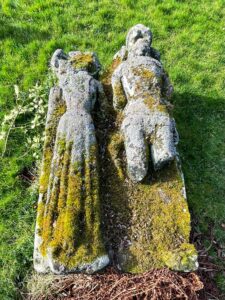Kirkby-in-Cleveland (or Kirby, for those who prefer brevity) is an ancient settlement, though that much is obvious. The name could either come from old Scandinavian, meaning “the farm by the church,” or from Adam de Kirkby, a Norman baron who once lived in the village and generously handed over land to Guisborough Priory. According to the Domesday Survey, the village had three carucates of tilled land, which is to say, a modest amount. Between the 12th and 16th centuries, land grants were also made to the Abbeys at Whitby, Fountains, and Rievaulx, proving that many souls needed to be saved1Leaflet published by the Kirby, Great Broughton & Ingleby Greenhow Local History Group http://www.kgbighistory.org.uk.
St. Augustine’s church is supposedly the fourth on this spot. The medieval building, itself a replacement for earlier Saxon and Norman structures, eventually fell apart and was rebuilt in 1815. Not content with that, they enlarged the chancel in 19052Church Heritage Record — Church Code 643565 https://facultyonline.churchofengland.org/CHR/ChurchDetails.aspx?id=15232#Home. Some stone from an earlier church was used in the vestry, which at least gives a nod to the past. Architectural historian Pevsner, never one to mince words, had little patience for the result: “If only it had been left alone,” he sighed3Pevsner, Nikolaus. “The Buildings of England – Yorkshire – The North Riding”. Penguin Books. Reprinted 1985. ISBN 0 14 071009 9.

Traces of the Saxon church have been found just north of the current building, where there is also this severely weathered tomb featuring a pair of recumbent effigies. These figures, supposedly representing a member of the de Eure family and his wife, have suffered greatly under centuries of rain and frost. She has lost her head while he has lost his legs below the knee. A sorry sight.
The stone slab on which these figures recline has also had a hard time. A corner was broken, then supposedly repaired with iron clasps, though one wonders how much good that did. It measures about six feet by three and rests on stones in a vaguely tomb-like fashion. In 1815, during the church’s reconstruction, workmen helpfully defaced it further, ensuring that little of its original dignity remains. The old church once stood where this battered monument now lies, so at least it has not strayed too far4‘Cleveland Revisited Saxon Kirkby—Its Ancient Church and Stone Effigies. | Cleveland Standard | 04 February 1933 | British Newspaper Archive’. 2022. Britishnewspaperarchive.co.uk <https://www.britishnewspaperarchive.co.uk/viewer/bl/0003490/19330204/107/0008https://www.britishnewspaperarchive.co.uk/viewer/bl/0003490/19330204/107/0008> [accessed 22 July 2022].
A more colourful explanation for these figures appeared in a Victorian newspaper5Yorkshire Post and Leeds Intelligencer – 11 February 1875 | MISCELLANEOUS RURAL NOTES | Britishnewspaperarchive.co.uk <https://www.britishnewspaperarchive.co.uk/viewer/bl/0000686/18750211/089/0002. According to local legend, they are “Locky and his Wife.” Locky, a tireless worker, once boasted he could sow a four-acre field if his wife raked behind him. She, equally deluded about her abilities, agreed to the challenge. The task proved too much; both worked themselves to death. Their toil, however, was not in vain, for their legacy supposedly lives on in this stone effigy. A field in the neighbouring township of Broughton was even named “Locky’s Day’s Work,” though whether this appears on old tithe maps is anyone’s guess.
It is tempting to wonder if Locky and de Eure, the Lord of the Manor, were in fact one and the same. However, given the rather large gap between feudal lords and overworked peasants, this seems unlikely. One does not expect a knight and his lady, wealthy enough to commission carved effigies, to also spend their days labouring in the fields. But then, history is full of contradictions.
- 1Leaflet published by the Kirby, Great Broughton & Ingleby Greenhow Local History Group http://www.kgbighistory.org.uk
- 2Church Heritage Record — Church Code 643565 https://facultyonline.churchofengland.org/CHR/ChurchDetails.aspx?id=15232#Home
- 3Pevsner, Nikolaus. “The Buildings of England – Yorkshire – The North Riding”. Penguin Books. Reprinted 1985. ISBN 0 14 071009 9
- 4‘Cleveland Revisited Saxon Kirkby—Its Ancient Church and Stone Effigies. | Cleveland Standard | 04 February 1933 | British Newspaper Archive’. 2022. Britishnewspaperarchive.co.uk <https://www.britishnewspaperarchive.co.uk/viewer/bl/0003490/19330204/107/0008https://www.britishnewspaperarchive.co.uk/viewer/bl/0003490/19330204/107/0008> [accessed 22 July 2022]
- 5Yorkshire Post and Leeds Intelligencer – 11 February 1875 | MISCELLANEOUS RURAL NOTES | Britishnewspaperarchive.co.uk <https://www.britishnewspaperarchive.co.uk/viewer/bl/0000686/18750211/089/0002

Leave a Reply